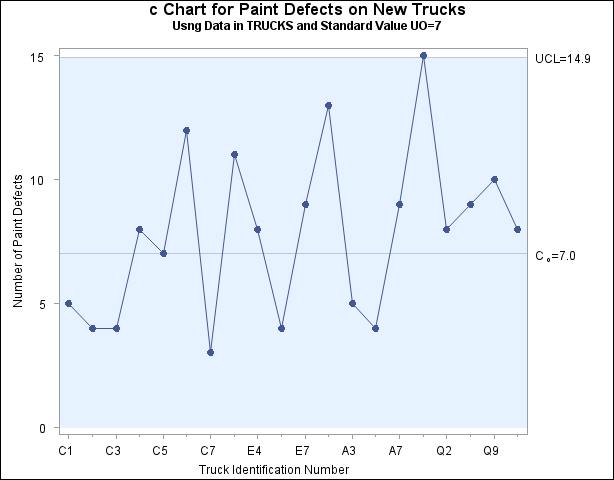CCHART Statement: SHEWHART Procedure
Example 15.9 Specifying a Known Expected Number of Nonconformities
[See SHWCEX2 in the SAS/QC Sample Library]This example illustrates how you can create a  chart based on a known (standard) value
chart based on a known (standard) value  for the expected number of nonconformities per unit.
for the expected number of nonconformities per unit.
A  chart is used to monitor the number of paint defects per truck. The defect counts are provided as values of the variable Defects in the data set Trucks given in Creating c Charts from Defect Count Data. Based on previous testing, it is known that
chart is used to monitor the number of paint defects per truck. The defect counts are provided as values of the variable Defects in the data set Trucks given in Creating c Charts from Defect Count Data. Based on previous testing, it is known that  . The following statements create a
. The following statements create a  chart with control limits derived from this value:
chart with control limits derived from this value:
ods graphics off;
symbol v=dot;
title 'c Chart for Paint Defects on New Trucks';
title2 'Usng Data in TRUCKS and Standard Value UO=7';
proc shewhart data=Trucks;
cchart Defects*TruckID / u0 = 7
csymbol = c0
nolegend
nolimitslegend
nolimit0;
run;
The chart is shown in Output 15.9.1. The U0= option specifies  , and the CSYMBOL= option requests a label for the central line indicating that the line represents a standard value. The NOLEGEND option suppresses the legend for the subgroup sample size, and the NOLIMITSLEGEND option suppresses the legend for the control limits that appears by default in the upper right corner of the chart. The NOLIMIT0 option suppresses the display of the lower limit when it is equal to zero.
, and the CSYMBOL= option requests a label for the central line indicating that the line represents a standard value. The NOLEGEND option suppresses the legend for the subgroup sample size, and the NOLIMITSLEGEND option suppresses the legend for the control limits that appears by default in the upper right corner of the chart. The NOLIMIT0 option suppresses the display of the lower limit when it is equal to zero.
 Chart with Standard Value
Chart with Standard Value 

The number of paint defects on Truck Q1 exceeds the upper control limit, indicating that the process is out of control.
Alternatively, you can specify  as the value of the variable _U_ in a LIMITS= data set, as follows:
as the value of the variable _U_ in a LIMITS= data set, as follows:
data tlimits;
length _subgrp_ _var_ _type_ $8;
_U_ = 7;
_subgrp_ = 'truckid';
_var_ = 'defects';
_limitn_ = 1;
_type_ = 'STANDARD';
proc shewhart data=trucks limits=tlimits;
cchart defects*truckid / csymbol=c0
nolegend
nolimitslegend
nolimit0;
run;
The chart produced by these statements is identical to the one in Output 15.9.1.
For further details, see LIMITS= Data Set.
